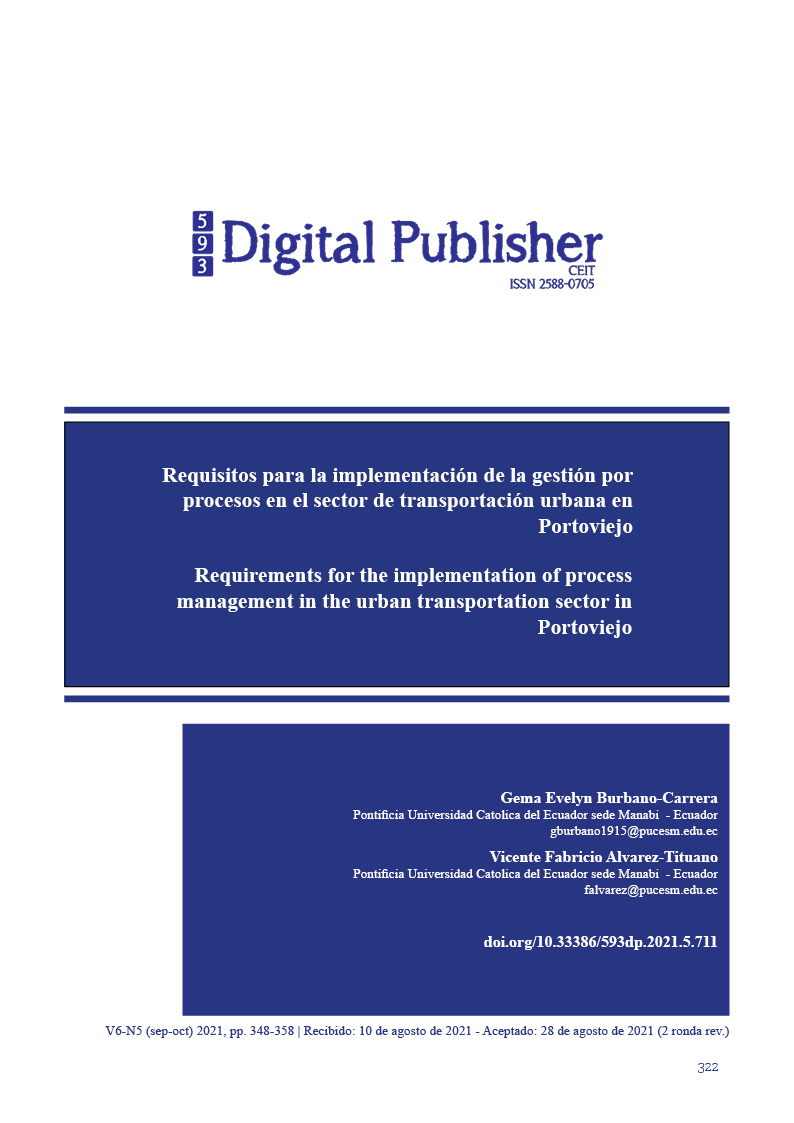Requirements for the implementation of process management in the urban transportation sector in Portoviejo
Main Article Content
Abstract
The micro, small and medium enterprises (MiPymes) that currently exist in Ecuador, are a fundamental part for the growth of production, the generation of jobs, innovation and the productive dynamism of the country. On the other hand, the urban transportation sector according to the International Standard Classification (ISIC) is part of the H sector referring to transportation and storage, becoming a fundamental service for the development of the city of Buenos Aires. It should be added that to provide a quality service requires a timely adaptation to the changes generated in the 21st century by technological advances, for this reason the search for new methods is essential, as is the case of a management approach by processes that allow generating continuous improvements in its organizational management, contributing to the achievement of the objectives and proposed plans. That is why the present research aims to describe the necessary requirements for the implementation of a process management model in SMEs in the urban transportation sector of Portoviejo. Therefore, by establishing a process management model, continuous improvement will be achieved in each of the processes carried out in the transportation industry.
Downloads
Article Details

This work is licensed under a Creative Commons Attribution-NonCommercial-ShareAlike 4.0 International License.
1. Derechos de autor
Las obras que se publican en 593 Digital Publisher CEIT están sujetas a los siguientes términos:
1.1. 593 Digital Publisher CEIT, conserva los derechos patrimoniales (copyright) de las obras publicadas, favorece y permite la reutilización de las mismas bajo la licencia Licencia Creative Commons 4.0 de Reconocimiento-NoComercial-CompartirIgual 4.0, por lo cual se pueden copiar, usar, difundir, transmitir y exponer públicamente, siempre que:
1.1.a. Se cite la autoría y fuente original de su publicación (revista, editorial, URL).
1.1.b. No se usen para fines comerciales u onerosos.
1.1.c. Se mencione la existencia y especificaciones de esta licencia de uso.
References
Banco Interamericano de Desarrollo. (2006). La Microempresa en Ecuador: perspectivas, desafíos y lineamientos de apoyo.
Chávez Cruz, G., Campuzano Vásquez, J., & Betancourt Gonzaga, V. (2019). Las micro, pequeñas y medianas empresas. Revista Pedagógica de La Universidad de Cienfuegos, 15(1990–8644), 190–195. https://conrado.ucf.edu.cu/index.php/conrado/issue/view/46
Chico Quishpe, E. V., & Suárez Rodríguez, A. M. (2014). Análisis del microcrédito como alternativa de financiamiento para las micro y pequeñas empresas del cantón Cayambe. In Tesis. http://dspace.ups.edu.ec/bitstream/123456789/5081/1/UPS-CYT00109.pdf
Directorio de Empresas y Establecimientos 2019. (2020). Boletín Técnico No. 01-2020-DIEE.
Instituto Nacional de Estadísticas y Censos INEC. (2019). Boletín técnico N° 04-2019-ENEMDU / Base de datos. In Encuesta Nacional de Empleo, Desempleo y Subempleo (ENEMDU), diciembre 2019. https://www.ecuadorencifras.gob.ec/enemdu-2019/
Mallar, M. Á. (2013). La gestión por procesos: Un enfoque de gestión eficiente. Journal of Chemical Information and Modeling, 53(9), 11–13.
Nicola Macias, L. A. (2015). Análisis sectorial de las micro, pequeñas y medianas empresas de la provincia de Guayas.
Orueta, I. (2017). Importancia económica de las PYMES en las economías iberoamericanas. https://www.iimv.org/iimv-wp-1-0/resources/uploads/2017/03/CAPITULO-1.pdf
Ron Amores, R. E., & Sacoto Castillo, V. A. (2017). Las PYMES ecuatorianas: su impacto en el empleo como contribución del PIB PYMES al PIB total. Revista Espacios, 38, 15.
Virginia, L., Adriana, A., Jack, Z., & Xavier, O. (2020). Global Entrepreneurship Monitor Ecuador 2020. ESPAE, ESCUELA DE NEGOCIOS, 8(2).



